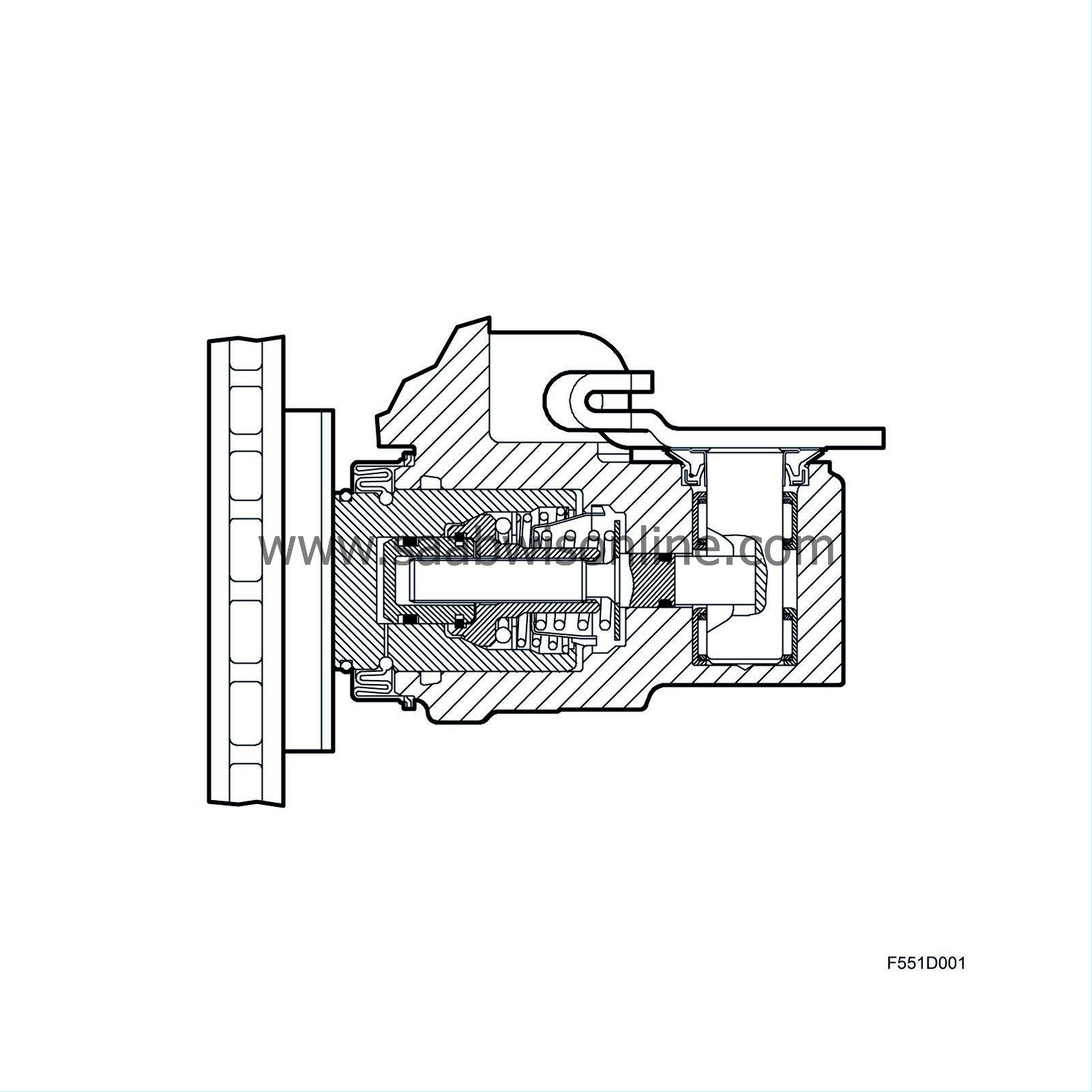Foot brake
| Foot brake |
| 1. |
Brake pedal
|
|
| 2. |
Servo unit
|
|
| 3. |
Master cylinder
|
|
| 4. |
Front brake caliper
|
|
| 5. |
Rear brake caliper
|
|
| 6. |
Brake disc
|
|
The foot brake system is operated with the brake pedal and acts hydraulically on all wheels. When the brake pedal (1) is pressed, it acts mechanically via the servo unit (2) on two pistons in the master cylinder (3).
The servo amplifies the outgoing pedal force and the increased pressure on the pistons in the master cylinder is conveyed simultaneously but divided into two hydraulic circuits to the front (4) and rear (5) wheel brakes. The brake calipers front and rear are self-adjusting, i.e. they continually compensate for wear in the brake pads.
Depending on the version of the braking system, the rear brake discs are either solid or ventilated. See also technical data Brakes - Footbrake system - Technical data - Brake discs, Brakes - Footbrake system - Technical data - Brake pads and Brake caliper .
| Brake circuits |

The brake system is divided into a primary and secondary circuit. The primary circuit comprises the left front and right rear wheel brakes while the secondary circuit comprises the right front and left rear wheel brakes. At the wheel brakes, the brake pistons are pressed out and push the brake pads against the brake discs. If a brake circuit should fail due to leakage, for instance, braking power will still be available in the other circuit.
| System components |
The brake servo unit boosts the pressure on the brake pedal exerted by the driver when the brakes are applied. The extra power supplied by the servo unit is obtained from the difference between the vacuum in the engine intake manifold or the vacuum pump and atmospheric pressure. In order to achieve this servo assistance in a compact design, the servo unit has dual operating chambers.
The brake servo unit includes the Mechanical Brake Assist (MBA) function which provides more powerful vacuum assistance during lower pedal pressure than previously available. This has been accomplished with modified control valve calibration for regulating vacuum/atmospheric pressure in the brake servo unit. At pedal pressures of 500 N, an output force of approx. 4200 N is achieved compared with a normal force of 3000 N.
The servo unit is attached to the intake manifold and vacuum pump by means of a hose. The servo unit consists of a metal casing, valve unit and dual diaphragms mounted between the brake pedal and master cylinder and is connected to them by pushrods. If the supply of vacuum to the servo unit is lost, the two pushrods act as a single pushrod. The brakes will then work conventionally without servo assistance but much greater pedal force will be required.
The master brake cylinder, which is mounted on the brake servo unit, contains a secondary and primary piston. The brake fluid reservoir is fitted on the master cylinder with separate chambers for the primary and secondary circuits.
In cars with a manual gearbox, the brake fluid reservoir serves as the reservoir for brake fluid used in clutch system. A brake fluid level switch is mounted on the brake fluid reservoir. The Level switch contains a float magnet which affects a reed element that closes an electric circuit and warns the driver regarding the condition.
| Vacuum pump |
In order to ensure that negative pressure is available to the brake servo unit, the car contains a vacuum pump. The pump provides the brake servo unit with negative pressure when the engine cannot properly accommodate the requirement.
The mechanical vacuum pump delivers maximum vacuum irrespective of engine rpm. This means that the pump, in certain situations, delivers more negative pressure than the system uses.
In a situation with an idling engine and a stationary car, the brake pedal may feel "soft" and sink somewhat lower than normal when applied. This is completely normal and will not affect braking force in a negative manner.
The ring type pump, which is lubricated by the engine lubrication system, is mounted on the master cylinder and is driven by the exhaust camshaft. Since it is connected to the camshaft, the speed of the pump is half that of the engine and a negative pressure of 0.8 Kpa (0.8 bar) is produced continually for the brake system.
| Brake caliper |
Brake caliper, front
The lightweight front brake caliper is manufactured with material which is a combination of aluminium and cast iron. The swinging caliper contains a hydraulic piston and two guide pins.
Brake caliper, rear
The swinging rear brake caliper is manufactured with aluminium and contains a hydraulic piston and two guide pins. A mechanism for both the handbrake and self-adjustment are also included.



